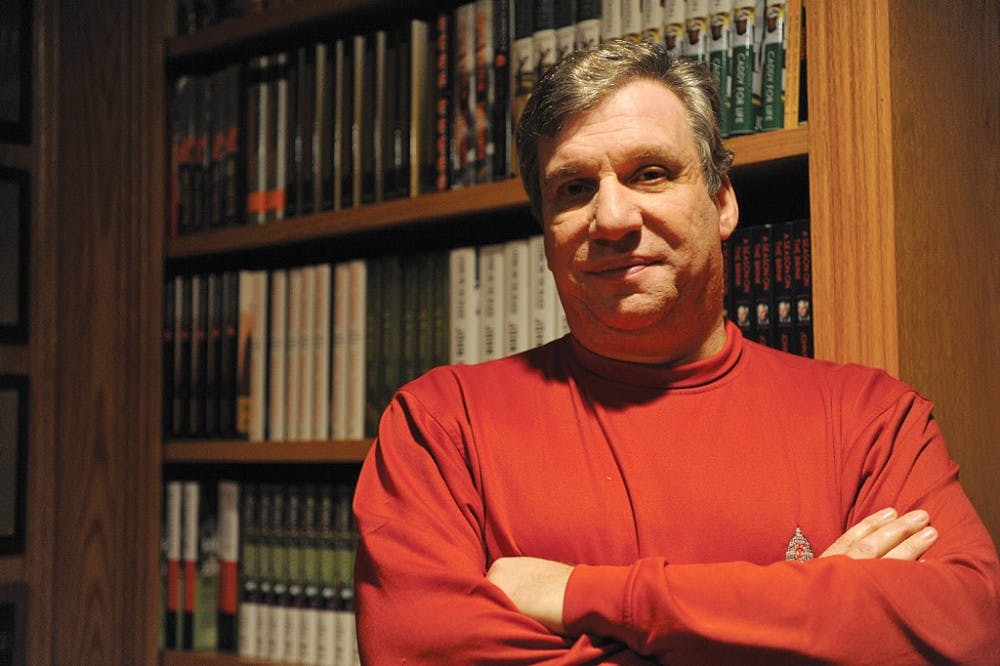The Chronicle’s Michael Model spoke with former Chronicle sports editor and renowned sports author John Feinstein to break down the evolution of the battle of Tobacco Road and what makes it one of the most special rivalries in all of sports. Their conversation has been edited for length and clarity.
The Chronicle: What aspects of the Duke-North Carolina rivalry make it stand out as the best in sports?
John Feinstein: I think the fact that the two schools are 10 miles apart…and the fans of the two schools actually live together. It’s not like Michigan-Ohio State, it’s not like Army-Navy—as great a rivalry that is…. The fact that they basically share the same community and they share the same media…and, they play at least twice a year every single year, sometimes three times. Back when I was in school when the Big Four tournament existed, there were years when they even played four times.
So, you know you’re going to face them twice a year and both teams have been, generally speaking, really good every year since 1978 when Bill Foster turned the Duke program around and went to the Final Four. Carolina had a down year in ’02, they had a down year in ’10. Duke had a down year in 1995 when Krzyzewski was out with a back problem. But, really for 40-plus years, they’ve been top-10 type teams when they’ve met.
TC: You’ve written a lot about the coaches involved: Mike Krzyzewski, Roy Williams and Dean Smith. How much have their successes influenced the prestige of the rivalry?
JF: You’re talking three Hall of Fame coaches. You’re talking coaches that have combined to win 10 national championships and have been to 32 Final Fours combined and uncountable ACC championships, both regular season and tournament. Mike and Dean, everybody knows, did not get along most of the time when they coached against each other. Roy and Mike have certainly had their moments through the years, I think they get along much better now that they’re both elder statesmen in the game. But it’s always been intense because they recruit against each other a lot and obviously play two or three times every year. It is unique in all those senses.
TC: Duke and North Carolina have been battling since 1920. At what point during the last 99 years do you feel the rivalry peaked?
JF: I don’t know that there’s a particular peak period or peak moment. I do remember back in 1991 when they both made the Final Four and there was a possibility of them playing in the national championship game. I think the thought of that terrified both sides because the notion of losing to the other for a national championship was just terrifying. Krzyzewski tells a story that when Carolina lost to Kansas in the first game that evening, he actually walked into the locker room and said to the players, ‘Look, Carolina lost and I’m not going to pretend that’s not a big deal for us. It is, but now you have to take that thought and flush it.’
They were about to go play UNLV, but he acknowledged the fact that knowing they would not have to face Carolina in the championship game, if they got there, was in fact a big deal. One of the things I’ve always admired about Mike is that he’s so honest about things like that. He doesn’t say, ‘Oh, Carolina’s just another game,’ and clearly it’s not.
TC: Are there any moments or people in the rivalry that have either been lost in time or overshadowed?
JF: Vic Bubas was the first guy who built the Duke program. He didn’t win a national championship, but he won four ACC titles in 10 years, went to three Final Fours and really made Duke into a national power, which it had not been…. The year after I graduated, Bill Foster had built the program. It took three years, but he built it and they went to the Final Four, they went to the national championship game in 1978 and lost to Kentucky. Even though they didn’t get back the next two years, they were very good with Jim Spanarkel, Mike Gminski, Gene Banks and Kenny Dennard, and people forget they went to the Elite Eight Bill Foster’s last year.
Then, Krzyzewski came in and it took him a couple years to turn it around—he went 38-47 his first three years—and there were people screaming that he should be fired. Tom Butters, to his credit, said no. Mike turned it around in ‘84 and you know the rest since then. But certainly Vic Bubas and Bill Foster are names that Duke people shouldn’t forget. Also, there were all sorts of very good players going back to the ‘60s: Bob Verga, Jeff Mullins and then my era Tate Armstrong was on Dean’s Olympic team in ’76 and was a terrific player and a first-round NBA Draft pick, but again didn’t get noticed because all four years he was in school—we were classmates—Duke was pretty terrible.
This is part of our extensive preview coverage for this year's first meeting between Duke and North Carolina. Check out more of our content here, including top games of this season and historically for the Blue Devils, breakdowns of the matchups at every position for Wednesday night and our writers' predictions for the game.
Get The Chronicle straight to your inbox
Signup for our weekly newsletter. Cancel at any time.
Digital Strategy Director for Vol. 115, Michael was previously Sports Editor for Vol. 114 and Assistant Blue Zone Editor for Vol. 113. Michael is a senior majoring in Statistical Science and is interested in data analytics and using data to make insights.

